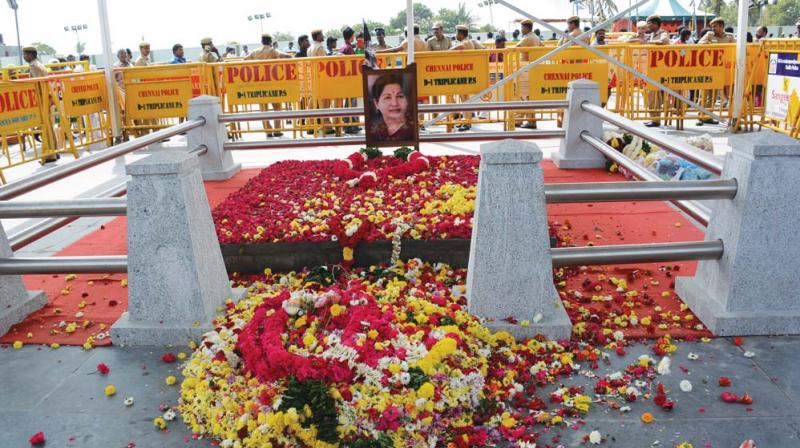Why calls to remove Jayalalithaa portraits are misplaced

Chennai: In a week of political turmoil in Tamil Nadu, particularly after the Supreme Court’s 570-page emphatic verdict in the disproportionate assets (DA) case involving the late Chief Minister, J Jayalalithaa, her confidante and now AIADMK general secretary, V.K. Sasikala and two of her kin, endearing terms of social bonding like ‘Annan, Thambi and Akka’, the hallmark of Dravidian politics, may be redrawing their semantic boundaries.
Popular consciousness is now quick to debunk all the good work of Jayalalithaa as Chief Minister for three long terms. Her pithy one-liner, ‘Makkalal Naan, Makkalukaga Naan (I am by the people, I am for the people),” is now seen as far from being an I-Thou doctrine that defined the once unassailable AIADMK leader, since the Apex court’s orders.
However, given the intensity of the blow that the judgment imparted and the enormity of its implications for the polity on issues like corruption and governance, a subtle, legal line drawn by the Apex court yet bestowed a saving grace to late Jayalalithaa.
This is borne out by legal experts split over whether the Apex court actually convicted Ms. Jayalalithaa or not, while “affirming and restoring the judgment of the Trial court in Karnataka in toto”, vis-à-vis the four persons accused in the DA case.
Some senior Supreme court lawyers say only the sentences against Jayalalithaa have abated as the person is no more, while other legal pundits contend that as the “appeals against Jayalalithaa” have abated with the ‘sole public servant’ and first accused in the case having expired in December last year after the conclusion of arguments earlier, the Apex court upholding the conviction covers only Ms. Sasikala and the two others.
Notwithstanding these open-ended readings that flow from the Apex Court’s resounding verdict, they have, albeit unwittingly, saved Jayalalithaa from what may be termed Calvinist predilections of ‘eternal damnation’.
As per the view of ‘predestination’ in Calvinism, God is believed to have assigned ‘salvation’ only to a select few, while the rest ‘receive eternal damnation’, a tenet challenged by Church reformers later.
Significantly, as the Supreme Court verdict says, “reference to her (Ms Jayalalithaa’s) role and involvement, based thereon in collaboration with other respondents would have to be essentially examined.” Yet, her death prior to the verdict, removed the ‘referent’ corresponding to the ‘first accused’, thereby assuring her an honoured metaphysical space.
This wonder-paradox in fact harks back to one of the toughest problems in modern analytical philosophy of ‘sense and reference’. How is something meaningful/truthful even if the person to whom it refers to no longer exists? From Bertrand Russell, W.V. O. Quine, to Peter Strawson, Daya Krishna, Ramchandra Gandhi and Saul Kripke, some of our most distinguished 20th century philosophers, it is still a raging debate; no wonder great human civilizations with loads of wisdom say, ‘we don’t speak ill of the dead’.
Aside from these philosophical underpinnings, what is of immediate relevance to the socio-political context here, is that a larger and fuller assessment of Ms Jayalalithaa as a woman political leader and Chief Minister of Tamil Nadu would have to await a more rigorous, fuller and balanced study by reasonably objective historians at a later date.
The Supreme Court’s ‘posthumous indictment’ of Ms Jayalalithaa, as some descriptions in the National media put it, is only regarding the reference period of the DA case (1991-96), coinciding with her first term as Chief Minister.
Though she took several steps for the rapid, long-term development of Tamil Nadu even then — like catalysing the first big ticket industrial investments under the new Economic reforms, the major legal step by her regime to secure Constitutional protection for the 69 per cent reservation for the OBCs’ and Dalits in Tamil Nadu, and steps for women’s empowerment including the launching of the first All Women Police Stations-, several of her Government’s far-reaching welfare measures like the temple ‘Annadaanam’ scheme and the ‘Amma canteens’, took effect during her two subsequent tenures amid the legal interruptions in between.
There may be other areas like prohibition for instance, where failure to take decisive action, or the legal overdrive in river-water sharing issues that may have socially cost Tamil Nadu heavily. But history is no halfway house, and the sociology of any society is a continuously evolving one.
The dismal vulnerability of ‘family rule’ in a society where caste and forces of economic production are so tightly knit, are better countered by viable, alternate models, something that a great leader like Mahatma Gandhi showed all his life through ‘disinterested social action’.
And again, the spirit of the ‘Karma Yogi’, as in the ‘Bhagavad Gita’, that Gandhi spoke about is totally different from the ‘Hindutva’ that is politically touted today as the panacea for all social ills including corruption in the public sphere.
It is in this backdrop that the demand by some political parties in Tamil Nadu and some activist groups to remove all portraits of former Chief Minister Ms.
Jayalalithaa from all government offices and even “shift” her ‘Samadhi’ from the Marina sands in Chennai in the wake of the Supreme court verdict in the DA case, looks highly misplaced and unwarranted.
Rushing to the pulpit to make hypercritical moral judgments just to score political brownie points amid a growing impatient youth constituency would only amount to denying our own collective history. As Mahatma Gandhi himself said in another context, “ultimate judgments” should be left to God!

